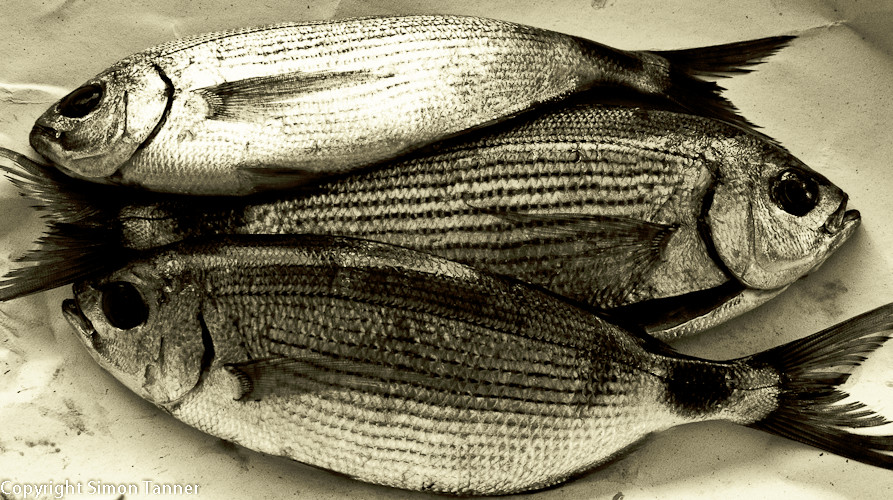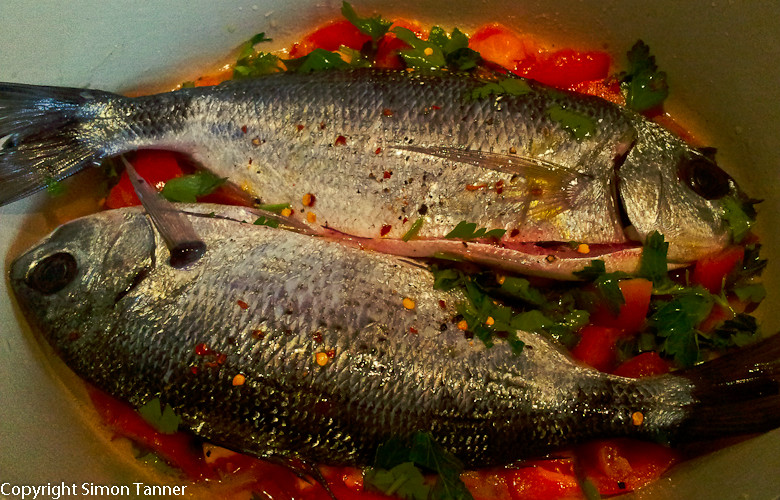Read this post in / Anche disponibile in: Italian
 Despite a few problems caused by the fact that the dialect name for this fish here in Messina is biata, I did in the end manage to find the Italian equivalent (occhiata), which led me to the English translation. As a result, I can confidently confirm that the fish I cooked was saddled seabream, also trading under the rather more poetic alias of Oblada melanura. The best way to identify it, I learned, apart from the general shape and stripes, is the black spot near the tail (which I can only presume is the ‘saddle’ referred to in its English name).
Despite a few problems caused by the fact that the dialect name for this fish here in Messina is biata, I did in the end manage to find the Italian equivalent (occhiata), which led me to the English translation. As a result, I can confidently confirm that the fish I cooked was saddled seabream, also trading under the rather more poetic alias of Oblada melanura. The best way to identify it, I learned, apart from the general shape and stripes, is the black spot near the tail (which I can only presume is the ‘saddle’ referred to in its English name).
 This, like other members of the seabream family, makes great eating, with delicate, tender meat. I usually serve it simply grilled with a drizzle of olive oil, a squeeze of lemon juice, and a sprinkle of salt and pepper. And in fact, that’s how one of yesterday’s haul ended up. But, just for a change, I thought I’d do the rest “all’acqua pazza” (literally with “mad water”). This is a popular way of cooking fish in the south of Italy, in a lightly aromatic tomato and garlic broth. I don’t know where the name comes from, but imagine it’s down to the spiciness of the broth, provided by black pepper and/or chillis. However, in my recipe the name is slightly (well, very, to be honest) misleading, since I don’t actually use water at all. I find that the wine, together with the cooking juices released by the fish and tomatoes provide quite enough liquid to cook the fish and produce a thin sauce.
This, like other members of the seabream family, makes great eating, with delicate, tender meat. I usually serve it simply grilled with a drizzle of olive oil, a squeeze of lemon juice, and a sprinkle of salt and pepper. And in fact, that’s how one of yesterday’s haul ended up. But, just for a change, I thought I’d do the rest “all’acqua pazza” (literally with “mad water”). This is a popular way of cooking fish in the south of Italy, in a lightly aromatic tomato and garlic broth. I don’t know where the name comes from, but imagine it’s down to the spiciness of the broth, provided by black pepper and/or chillis. However, in my recipe the name is slightly (well, very, to be honest) misleading, since I don’t actually use water at all. I find that the wine, together with the cooking juices released by the fish and tomatoes provide quite enough liquid to cook the fish and produce a thin sauce.
This method, unsurprisingly, also works well for other members of the bream family, such as sheepshead bream, red bream and gilt-head bream, and also for sea bass. In fact, I imagine, for any delicate-flavoured white fish. It also has the merit of being quick and simple. You could of course also use fish fillets for the recipe, but it won’t be quite the same.
One thing you should do is ask your fishmonger to descale the fish for you. I forgot, and so had to do it myself. It’s not difficult, but you do tend to end up covered in fish scales, which fly off in unpredictable directions. In fact, an Italian fishmonger will often ask you how you want to cook your fish. If you’re grilling it, he’ll leave the scales on, to act as a further layer of protection for the delicate meat. If you’re serving it stewed, he’ll take them off, because the last thing you want is your broth full of the things – tiny, hard and inedible.
 For 2-4 (depending how hungry you are!):
For 2-4 (depending how hungry you are!):
- 2 saddled bream of about 400g each, gutted, descaled and washed
- 3 ripe tomatoes or 300g cherry tomatoes, roughly chopped
- 3 cloves of garlic, sliced in half lengthways
- Small bunch of parsley, chopped
- 100ml dry white wine
- Extra virgin olive oil
- Sea salt and freshly ground black pepper
- Dry or fresh chilli pepper, to taste (optional)
- In a casserole dish or non-stick saucepan (preferably oval; necessarily with a lid), mix the tomatoes with some salt and pepper (and chilli, if using), two of the garlic cloves, most of the parsley and two tablespoons of oil.
- Place the fish on the tomatoes, and season the stomach cavity of each with salt, pepper, half a clove of garlic and a little parsley.
- Pour over the wine, season the outside of the fish with some more salt and pepper, and finish off with a final drizzle of olive oil.
- Cover and bring to the boil, then reduce the heat to a simmer, and continue to cook, covered, for 15 minutes. Don’t worry that the fish isn’t fully submerged in liquid. The whole idea of this method is that the fish is half stewed, half steamed.
- Remove the fish to warmed plates and reduce the broth over the highest heat you can muster for a couple of minutes. Serve with the fish.
A glass of some delicate, floral white and a chunk of crusty bread is all this needs, and is all mine got.
 English
English Italiano
Italiano